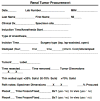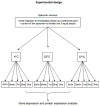Tissue-based research in kidney cancer: current challenges and future directions
- PMID: 18559586
- PMCID: PMC2586673
- DOI: 10.1158/1078-0432.CCR-07-4733
Tissue-based research in kidney cancer: current challenges and future directions
Abstract
The past several years have seen unprecedented advances in the application of various therapeutic strategies for the treatment of patients with renal cancer. The availability of active immunotherapy, antiangiogenic therapy, and targeted therapy for this disease has brought front and center issues related to choosing the appropriate treatment for particular patient populations. It is increasingly evident that the most promising treatment selection strategies will incorporate identifying specific features of the tumor itself. To facilitate this move toward personalized medicine, it is critically important to establish some standard principles for renal cancer tissue collection, preparation, and analysis for translational research studies. In this article, we identify and discuss some critical issues related to tissue-based kidney cancer research. We focus on five major areas as follows: (a) surgical and image-guided techniques for tissue collection; (b) quality control of specimen collection, processing, storage, and review; (c) issues related to analysis of paraffin embedded tissues; (d) genomic studies; and (e) assessment of reproducibility of assays across institutions. In addition, some practical implementation strategies are proposed. Although many of the topics discussed are specific for renal cancer, several are also relevant to tissue based biomarker investigations in a broad array of malignancies.
Figures


Similar articles
-
Expanding the Utilization of Formalin-Fixed, Paraffin-Embedded Archives: Feasibility of miR-Seq for Disease Exploration and Biomarker Development from Biopsies with Clear Cell Renal Cell Carcinoma.Int J Mol Sci. 2018 Mar 10;19(3):803. doi: 10.3390/ijms19030803. Int J Mol Sci. 2018. PMID: 29534467 Free PMC article.
-
[Renal cancer biomarkers. What is justified?].Pathologe. 2012 Nov;33 Suppl 2:278-81. doi: 10.1007/s00292-012-1683-8. Pathologe. 2012. PMID: 23052348 Review. German.
-
Translational research will fail without surgical leadership: SCOTRRCC a successful surgeon-led Nationwide translational research infrastructure in renal cancer.Surgeon. 2015 Aug;13(4):181-6. doi: 10.1016/j.surge.2015.03.001. Epub 2015 Apr 30. Surgeon. 2015. PMID: 25937514
-
Genomic classifications of renal cell carcinoma: a critical step towards the future application of personalized kidney cancer care with pan-omics precision.J Pathol. 2018 Apr;244(5):525-537. doi: 10.1002/path.5022. Epub 2018 Feb 14. J Pathol. 2018. PMID: 29266437 Review.
-
Characterization of Clinical Cases of Advanced Papillary Renal Cell Carcinoma via Comprehensive Genomic Profiling.Eur Urol. 2018 Jan;73(1):71-78. doi: 10.1016/j.eururo.2017.05.033. Epub 2017 Jun 4. Eur Urol. 2018. PMID: 28592388
Cited by
-
PD-L1 Expression and Clinical Outcomes to Cabozantinib, Everolimus, and Sunitinib in Patients with Metastatic Renal Cell Carcinoma: Analysis of the Randomized Clinical Trials METEOR and CABOSUN.Clin Cancer Res. 2019 Oct 15;25(20):6080-6088. doi: 10.1158/1078-0432.CCR-19-1135. Epub 2019 Aug 1. Clin Cancer Res. 2019. PMID: 31371341 Free PMC article.
-
Von Hippel-Lindau (VHL) inactivation in sporadic clear cell renal cancer: associations with germline VHL polymorphisms and etiologic risk factors.PLoS Genet. 2011 Oct;7(10):e1002312. doi: 10.1371/journal.pgen.1002312. Epub 2011 Oct 13. PLoS Genet. 2011. PMID: 22022277 Free PMC article.
-
The role of aberrant VHL/HIF pathway elements in predicting clinical outcome to pazopanib therapy in patients with metastatic clear-cell renal cell carcinoma.Clin Cancer Res. 2013 Sep 15;19(18):5218-26. doi: 10.1158/1078-0432.CCR-13-0491. Epub 2013 Jul 23. Clin Cancer Res. 2013. PMID: 23881929 Free PMC article. Clinical Trial.
-
Tissue biomarkers in renal cell carcinoma: issues and solutions.Cancer. 2009 May 15;115(10 Suppl):2290-7. doi: 10.1002/cncr.24233. Cancer. 2009. PMID: 19402057 Free PMC article. Review.
-
The surgical specimen is the personalized part of personalized cancer medicine.Ann Surg Oncol. 2009 Aug;16(8):2079-80. doi: 10.1245/s10434-009-0526-1. Epub 2009 May 27. Ann Surg Oncol. 2009. PMID: 19472010 Free PMC article. No abstract available.
References
-
- Atkins MB, Ernstoff MS, Figlin RA, Flaherty KT, George DJ, Kaelin WG, Jr, et al. Innovations and challenges in renal cell carcinoma: summary statement from the Second Cambridge Conference. Clin Cancer Res. 2007 Jan 15;13(2 Pt 2):667s–70s. - PubMed
-
- Brugarolas J. Renal-cell carcinoma--molecular pathways and therapies. N Engl J Med. 2007 Jan 11;356(2):185–7. - PubMed
-
- Lechevallier E, Andre M, Barriol D, Daniel L, Eghazarian C, De Fromont M, et al. Fine-needle percutaneous biopsy of renal masses with helical CT guidance. Radiology. 2000 Aug;216(2):506–10. - PubMed
-
- Rybicki FJ, Shu KM, Cibas ES, Fielding JR, vanSonnenberg E, Silverman SG. Percutaneous biopsy of renal masses: sensitivity and negative predictive value stratified by clinical setting and size of masses. AJR Am J Roentgenol. 2003 May;180(5):1281–7. - PubMed
-
- Volpe A, Kachura JR, Geddie WR, Evans AJ, Gharajeh A, Saravanan A, et al. Techniques, safety and accuracy of sampling of renal tumors by fine needle aspiration and core biopsy. J Urol. 2007 Aug;178(2):379–86. - PubMed
Publication types
MeSH terms
Substances
Grants and funding
LinkOut - more resources
Full Text Sources
Other Literature Sources
Medical
Miscellaneous

